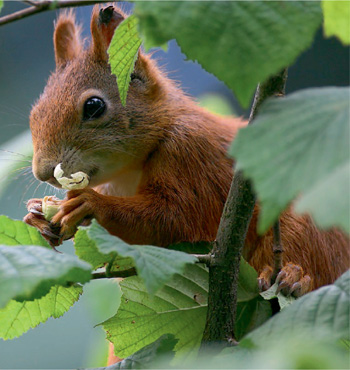
A Striped Field Mouse with a hazelnut. LG.

In all mammals only the lower jaw is mobile, and rodents can gnaw only with the teeth in their lower jaw. Mice work on hazelnuts in two ways.
Voles, such as Bank Vole, and Striped Field Mouse stick the upper front teeth into the shell and gnaw at the hole with their bottom incisors to make it larger, working from the outside towards the centre, so you see no marks of the upper teeth on the outside of the shell.

True mice such as Wood Mouse, Yellow-necked Mouse, and Northern Water Vole stick the lower teeth into the shell and gnaw an increasingly larger hole on the opposite side of the nut, from the inside out, while holding the nut with the upper teeth, turning the nut as they do so. The upper teeth leave noticeable marks on the outside of the hole just below the edge. Here we see the tooth marks of a Yellow-necked Mouse. LG.

Squirrels chew at the shell, then use the teeth in their lower jaw like a jimmy. Older squirrels, with stronger teeth and more experience, leave only a few tooth marks, younger ones more.

Green hazelnuts with signs of squirrel feeding.

Hazelnut with signs of feeding by a Great Tit. The beak marks of Great Tits are very small, and the birds prefer nuts that have not fully ripened, when the shell is still soft.

Hazelnut with the signs of feeding by a woodpecker. Left, with peck marks; on the right, an emptied nut.

The beak of a woodpecker is flattened at the tip; for this reason the marks on nuts run vertically. Beak marks of a Great Spotted Woodpecker are about 2 mm long. Woodpeckers wedge nuts in crevices of trees so they can peck at them, or they make a hole in a tree in which they fit the nut. At the foot of the tree, you can find many split nuts; this is what is called a woodpecker’s ‘workshop’. KS.


The tips of the beaks of Jay and Magpie are sharply pointed, and, as with nuthatches, only the tip of the beak leaves a mark on the shell of a nut. SS.


The upper mandible of a Nuthatch protrudes slightly over the lower, and this is the reason the beak marks resemble a half-moon. The birds lodge the nut in a natural crevice in the tree, where it often remains permanently stuck, reducing the accumulation of empty shells. GH.

Nutcracker in a pine, MH.

Nutcrackers cache provisions for winter in the ground. They hold a nut with one foot and often peck at its tip. Their pecking is so powerful that the shell is split in two. They work on nuts at special feeding sites, for instance on a stump or a moss-covered stone.

Small holes in hazelnuts and acorns are the work of hazelnut weevils; small holes in beechnuts are the work of leafroller larvae.
